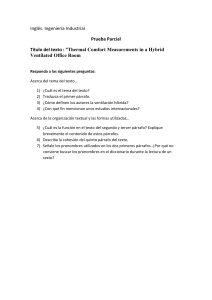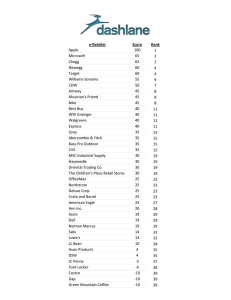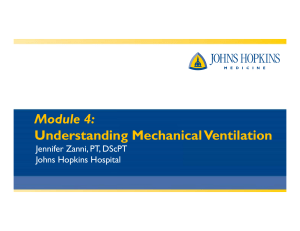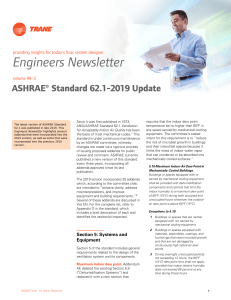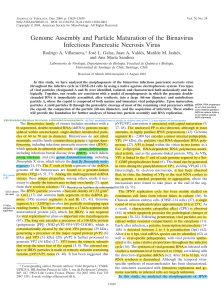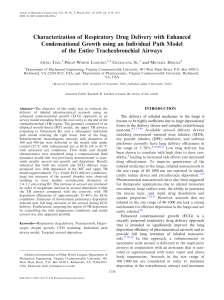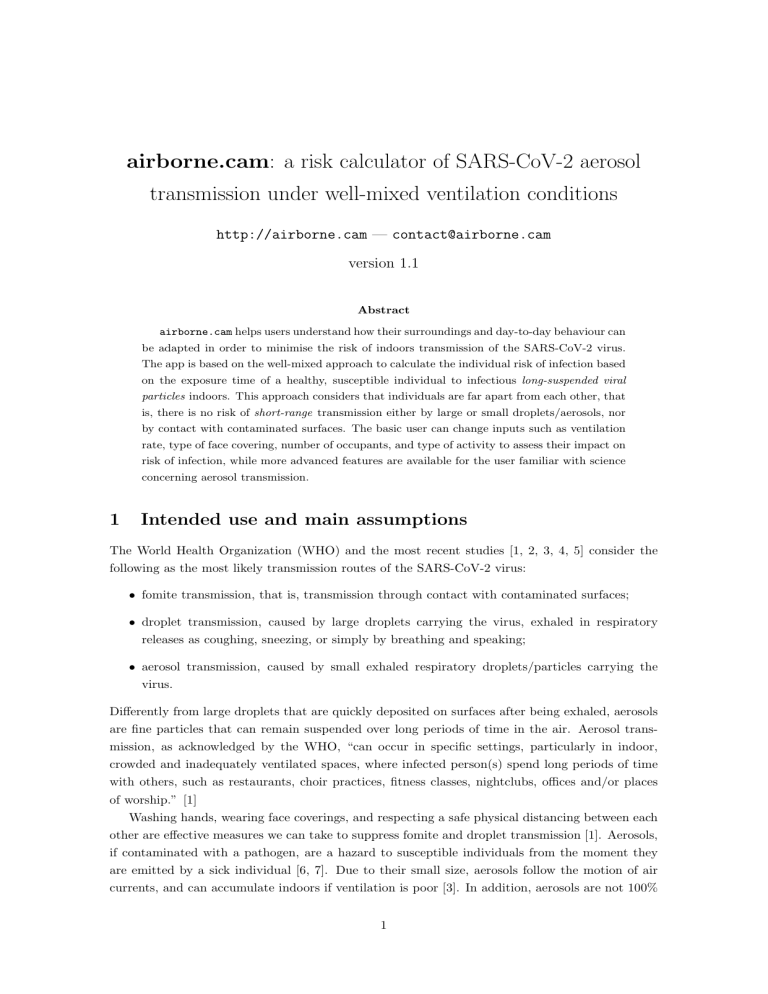
airborne.cam: a risk calculator of SARS-CoV-2 aerosol transmission under well-mixed ventilation conditions http://airborne.cam — [email protected] version 1.1 Abstract airborne.cam helps users understand how their surroundings and day-to-day behaviour can be adapted in order to minimise the risk of indoors transmission of the SARS-CoV-2 virus. The app is based on the well-mixed approach to calculate the individual risk of infection based on the exposure time of a healthy, susceptible individual to infectious long-suspended viral particles indoors. This approach considers that individuals are far apart from each other, that is, there is no risk of short-range transmission either by large or small droplets/aerosols, nor by contact with contaminated surfaces. The basic user can change inputs such as ventilation rate, type of face covering, number of occupants, and type of activity to assess their impact on risk of infection, while more advanced features are available for the user familiar with science concerning aerosol transmission. 1 Intended use and main assumptions The World Health Organization (WHO) and the most recent studies [1, 2, 3, 4, 5] consider the following as the most likely transmission routes of the SARS-CoV-2 virus: • fomite transmission, that is, transmission through contact with contaminated surfaces; • droplet transmission, caused by large droplets carrying the virus, exhaled in respiratory releases as coughing, sneezing, or simply by breathing and speaking; • aerosol transmission, caused by small exhaled respiratory droplets/particles carrying the virus. Differently from large droplets that are quickly deposited on surfaces after being exhaled, aerosols are fine particles that can remain suspended over long periods of time in the air. Aerosol transmission, as acknowledged by the WHO, “can occur in specific settings, particularly in indoor, crowded and inadequately ventilated spaces, where infected person(s) spend long periods of time with others, such as restaurants, choir practices, fitness classes, nightclubs, offices and/or places of worship.” [1] Washing hands, wearing face coverings, and respecting a safe physical distancing between each other are effective measures we can take to suppress fomite and droplet transmission [1]. Aerosols, if contaminated with a pathogen, are a hazard to susceptible individuals from the moment they are emitted by a sick individual [6, 7]. Due to their small size, aerosols follow the motion of air currents, and can accumulate indoors if ventilation is poor [3]. In addition, aerosols are not 100% 1 filtered by simple, cotton face coverings. Still, a series of actions can be taken to reduce risk of transmission indoors, such as improving ventilation, reducing exposure time in a contaminated setting and, most importantly, using masks that have a high efficiency in filtering aerosol, thus reducing both the amount of aerosol exhaled by a sick individual as well as the amount inhaled by a susceptible one. These factors, as well as others, are assessed in this app. airborne.cam estimates the risk of infection for a single individual considering only aerosol transmission due to accumulation of infectious viral particles in a specific indoor room with a specific activity, as set by the user. This does not mean that the other transmission routes mentioned are not relevant in an indoor context; rather, they are simply not accounted for in this approach. To put it simply, the user should consider that, on top of the risk estimates given by airborne.cam, there are additional risks related to exposure to contaminated surfaces and due to short-distance transmission through droplets/aerosol. Therefore, the results given by the app should be used as a way to understand how different parameters affect the transmission of the SARS-CoV-2 virus in this setting, and should not be used as a definitive or absolute evaluation of risk. To account for the effects of ventilation, which can mitigate contamination risk from aerosols [8], a well-mixed approach is employed. This approach considers ventilation scenarios where a ”mixing ventilation” strategy is used. Thus, our model considers that mixing between viral particles and air occurs faster than the purging times of a given ventilation system and hence the viral particles are homogeneously dispersed in the room. This may not be the case for every situation, but may often be a fair approximation.1 The transmission of the SARS-CoV-2 virus is a topic of active research. Hence, the uncertainties involved in the present calculation are high2 , which prevents the results given by this app from being used as an absolute quantification of risk of infection in a determined setting. The user should not consider that the indicated risk by the app is a precise quantification of the probability of being infected. The objective of the app is to help the user achieve a better understanding on the potential risk reductions by taking specific actions, such as wearing a particular type of mask, increase ventilation rate, or reduce exposure time. Moreover, airborne.cam should be used as a guide, so that users understand aerosol transmission as a function of their surroundings, interpreting which situations can pose a potential risk, but always keeping into consideration the guidelines issued by Authorities or the building manager (e.g., social distancing, use of masks). Needless to say, the app is not a substitute for a professional assessment of ventilation or of disease transmission risk for a given indoor scenario. We hope that the use of airborne.cam can improve the general knowledge on the importance of ventilation in reducing the risk of SARS-CoV-2 transmission through aerosols indoors and can help occupants and managers of indoor spaces make informed choices on risk mitigation measures. 1 Typically, ventilation patterns can create inhomogeneities in a room, that is, pockets of air that can have a high or a low concentration of viral particles. The well-mixed approximation is typically acceptable in situations where recirculating air systems (e.g., A/C, fans with closed windows etc.) and low “air changes per hour” (ACH) are used. In other settings, the air mixture is not uniform and emissions/virus concentration may vary spatially, being higher near the infected person and lower away from them. 2 For more information on the knowns and unknowns of the COVID-19 disease and the SARS-CoV-2 virus which affect the current modelling approach, the user is referred to the website compiled by researchers of the UK Centre for Doctoral Training in Aerosol Sciences, who summarised the recent scientific findings related to COVID-19 in https://aerosol-soc.com/covid-19/. Additionally, Royal Society’s Rapid Assistance in Modelling the Pandemic (RAMP) initiative, Task 7, have been updating a ventilation guide aiming at minimising the transmission of the virus, with focus on winter conditions (see https://arxiv.org/abs/2009.12781). 2 2 Using the app 2.1 Setting-up an indoors scenario In this Section, the various parameters that are input by the user are described. The Basic Mode needs information on occupancy, activity, face covering type, and ventilation rate, and these are sufficient to produce an estimate of the risk to an average healthy individual as a function of exposure time. The app uses many more parameters, whose numerical values come from the literature. In the Advanced Mode, greater customisation is possible, and the presence of air purifiers is also included. Basic Mode Under room, the user specifies the total floor area (in square metres) and ceiling height (metres) of the room being analysed. Next, under duration, the time duration of the event being analysed is set based on a given opening and closing time of the room set by the user. This defines the duration of the event, given in the horizontal axis of all plots of the interface. Here, it is important to note that the opening time should be set from the moment the room is first used. In other words, the room must be empty for a sufficiently long time before opening, so that it always starts with “clean” air. Then, ventilation settings are defined by the user. This is set in terms of air changes per hour (ACH). For example, for a room with a volume of 100 m3 , a ventilation rate of 1 ACH means that 100 m3 (or 100,000 litres) of outside air are brought in every hour. The app automatically calculates the equivalent in litres per second per person (l/s/person) based on the maximum occupancy set by the user for the room. Some countries have specific ventilation legislation for buildings, which are typically given in terms of l/s/person. Ventilation rates are usually defined based on those values for specific scenarios (office buildings, schools, hospitals), resulting in an absolute ventilation rate given in terms of ACH. Although typical values found in domestic, office, and hospital settings are given as reference values, the user also has the option of setting a custom ACH numerical value.3 Next, occupancy settings are defined. Maximum occupancy is given in terms of number of people. A constant, maximum occupancy is then assumed for the duration of the entire event. Alternatively, variable occupancy can also be set in the advanced mode, discussed further below. The user also specifies if susceptible individuals are using a mask (and if so, what type of mask), as well as the type of activity being carried out in the room. Finally, details about the infectious/sick individuals in the room are defined. Either a constant number of individuals is set or a relative value (%). If the latter is set, the absolute number of infectious individuals is calculated by the app based on the number of occupants in the room at a given instant. The relative, percent value of infectious individuals may be particularly useful in a scenario of variable occupancy – this can be set in the advanced mode. Finally, the user can also define a mask for the infectious occupants as well as the type of activity they are carrying out. 3 In spaces where forced ventilation systems are in use, the ventilation rate in air changes per hour is a parameter predefined for that particular system. However, in naturally ventilated settings, where windows are opened so outside air will flow into the room, it might be slightly more complicated to estimate an ACH value. For now, before this is implemented as a feature built into the app, the user is referred to section 4.1 of the WHO Natural ventilation guide (https://www.who.int/water_sanitation_health/publications/natural_ventilation/en/) to estimate the ACH in naturally ventilated spaces. 3 Advanced Mode In addition to the settings above, there is an advanced mode, which allows for more customisation. First, in the basic mode, it is assumed that the viral load – the concentration of viable virus in the saliva of sick individuals – is the same, and equal to 109 copies per ml. In the advanced mode, two other values can be set for reference. The number of viral particles in the aerosol is probably the greatest source of uncertainty in the present calculations. The advanced mode also allows the user to define a different size for the maximum particles carried by ventilation – this is commonly referred to as the aerosol cut-off size. This is understood to vary between 5-100 micrometres – stronger ventilation currents will be able to carry larger particles. There is also an option to set a vertical velocity of the air flows, which could be found in particular ventilation scenarios. Additionally, the user can the ventilation flow rate as a combination of outside air brought in and indoors air filtered and recirculated (not necessarily at 100% efficiency). Common filter settings are given based on the ISO 16890. These features of the advanced mode may be helpful to the ventilation expert. Finally, the advanced mode also allows for variable occupancy. Currently, this is based on a Gaussian function with predetermined settings. We hope to make this parameter more flexible in the future, so that more detailed information (e.g., Google maps “popular times” feature) can be used as an input. The user can also define evenly-spaced breaks throughout the day by using the regular breaks mode. 2.2 Application examples Example 1: Classroom and ACH Consider a room with 100 m2 floor area and 3 m ceiling height, occupied for 2 hours by 20 people. If only one of the occupants is infected, nobody is using masks and typical building ventilation with 3 ACH are in place, the risk of infection would evolve in time as shown by the curve in Fig. 1, leading to an estimated risk of infection of about 19% after 2 hours. If, however, the ACH is increased, the risk of infection would be reduced to 8.8% with ACH = 3, about 6% with ACH = 5, and 3.5% with ACH = 10. These results show the importance of a correct level of ventilation to minimise the estimated risk of infection. Example 2: Classroom and mask usage Consider the same room and occupancy scenario as in Example 1. Again, if only one of the occupants is infected, no occupants are using masks, and typical building ventilation with 3 ACH are in place, the risk of infection would evolve in time as shown by the respective curve in Fig. 1, leading to an estimated risk of infection of 8.8% after 2 hours. If, however, the occupants are using masks, the risk of infection will be reduced according to the type of masks used. The estimated risk becomes 3.8% if 1-ply cloth masks are used (Fig. 2), 2.2% if 3-ply cloth masks are used, 1.5% if surgical masks are used and 0.09% if FFP2/N95 masks are used. These results highlight not only the impact mask usage has on mitigating risk of transmission, but also how effective each mask type is for the given conditions. 4 Figure 1: Evolution in time of infection risk for a room with 100 m2 surface and 3 m height, occupied for 2 hours by 20 people, one of them infected, none with masks and ventilated with different “air changes per hour” (ACH). Figure 2: Evolution in time of infection risk for a room with 100 m2 surface and 3 m height, ventilated with 3 ACH and occupied for 2 hours by 20 people, one of them infected and (a) none with masks, (b) all using 1-ply cloth masks, (c) all using 3-ply cloth masks, (d) all using surgical masks and (e) all using FFP2/N95 masks. 5 3 Scientific basis The scientific basis of this app is given in detail in Ref. [5]. Here a few additions are made to improve the usability of the various models explained below. 3.1 Equations of mass balance Here a well-mixed condition is assumed, that is, that long suspended viral particles exhaled by an infectious person and air mix quickly, faster than the purging times of a given ventilation system. This way, a mass balance equation can be derived to find the temporal evolution of the particle concentration, C, within the room with volume V . Note that here we use the units PFU/m3 to denote the concentration of viable viral particles, or viral copies in the air4 (see section 3.4 for details). The equation reads dC ninf · (1 − ηmask ) · Ṅv,gen = − λ + κ + v + s C, dt V (1) where ninf the number of infected people within the room wearing a mask with capture efficiency ηmask and generating Ṅv,gen viral particles per unit of time emitted by continuous exhalation while speaking. During the same time of emission, the virus from aerosols is being removed via viral decay, λ, the settling of the aerosol droplets, κ, and ventilation, v. The ventilation rate can be expressed as v = Q/V = ACH with Q being the supply of outside air to the room and ACH the equivalent “air changes per hour”. A sterilisation rate can also be included in the removal mechanisms and here it is denoted as s. Equation (1) is a first-order linear ordinary differential equation which can be integrated over a time period [t0 ; t] to give C(t) = ninf · (1 − ηmask ) · Ṅv,gen V (λ + κ + v + s) + ninf · (1 − ηmask ) · Ṅv,gen C(t0 ) − V (λ + κ + v + s) (2) ! exp − (λ + κ + v + s)(t − t0 ) . Equation (2) is directly implemented in the app and various parameters can be changed, as described in section 2.1. When ninf > 0, i.e., when at least one infected person is present in the room, there is a competition between the generation of particles and their removal by ventilation, gravity and viral decay. For a given room volume and ventilation rate, the most crucial parameter is the total generation rate of viral particles which depends on multiple other parameters, explained in more detail later. When the infected occupants leave the room, there is a time delay until the viral particle concentration levels become negligible and safe. This time delay depends on the total removal rate and is dictated by a simplified version of Eq. 2 given by C(t) = C(t0 ) exp − (λ + κ + v + s)(t − t0 ) . (3) In the following, more details regarding the parameters Ṅv,gen , ηmask , λ, κ and s are provided. 4 Plaque forming units (PFU) are a virology metric that quantifies the amount (not the total number) able to cause infection. Knowledge of the total PFU inhaled by a person allows for the calculation of the risk via an infection dose model such as the one in Ref. [9]. 6 3.2 Exhalation of viral particles As explained in Refs. [10, 11], humans produce droplet and aerosol particles by expiratory activities: breathing, speaking, coughing or sneezing. Infectious pathogens, such as SARS-CoV-2, might be be carried by these particles, remaining viable for a long time before removed by ventilation or gravity. The total amount of particles suspended in the air can be calculated using (i) parameters for the initial size, type and composition of particles as emitted by a human, (ii) estimates for the initial amount of virus found in the sputum of an infected person, and (iii) physical models for the physical transformation of these particles, e.g., via evaporation, and their movement in a room. Such calculations have been performed for a range of scenarios in a comprehensive study in Ref. [5]. More calculations are planned for the future. Estimation of aerosol generation rate When relying on Eqs. 1–2 to calculate the amount of infectious particles (viable viral copies), the generation rate, Ṅv,gen , should correspond to the amount of aerosol, i.e., the particles that can remain suspended for long times and can follow the motion of air flows within a room, being capable to “mix” with the air. This is only a fraction of the particles emitted from the mouth, since larger droplets tend to settle on surfaces shortly after emission. The relative difference depends on a number of factors such as ambient conditions, flow conditions, droplet composition, and the initial (exhaled) particle size distribution. As discussed in Ref. [5], these factors can be incorporated into the generation rate using some assumptions5 . Typical values for the generation rate are given in Table 1, where Ṅv,gen is expressed as a function of upward air velocity, assumed cut-off diameter for aerosol and viral load in the sputum of the infected person(s). The upward air velocity is relevant for some scenarios, e.g., low-speed displacement ventilation, where upward air streams could delay the settling of particles and consequently increase the concentration of suspended particles. The generation rate is here considered to be also a function of the cut-off diameter for aerosol, that is the size threshold below which all particles are considered small enough to follow the flow, thus being removed by ventilation. Although the Stokes number of a particle or droplet, i.e., the ratio of its characteristic time scale to the flow time scale, is generally used to evaluate how these move in relation to air flows, an arbitrary size of 5—10 µm is often used to define aerosol particles [12]. Recent findings suggest that higher values should be used instead [12, 13]. In general, there is significant uncertainty in this area and it is not quite proper to assume a predefined cut-off value. This is something we aim to address in the future. Effect of viral load Despite the significant uncertainty regarding the concentration of suspended aerosol particles within the room, the highest uncertainty regarding the total amount of virus in the air lies with the initial viral load, Vl , found in the sputum of the infected person(s). The amount of virus depends on the progress of the disease. Measurements of RNA copies of virus in sputum show values ranging from 104 to 1010 viral copies/ml, while higher values have also been observed [6, 14, 15]. Additional uncertainty concerning that parameter exists simply because, until the present moment, no studies have been able to quantify the amount of viable viral copies in droplets/aerosol samples. Thus, 5 In future work, we aim to improve the estimation Ṅ v,gen and modify Eqs. 1–2 so that Ṅv,gen can be calculated without ambiguity. This would necessitate a formulation that considers all droplet sizes and not only aerosol particles. 7 Table 1: Values for the generation rate, Ṅv,gen , depending on conditions of upward air velocity, assumed cut-off diameter for the aerosol particles and the viral load, Vl , at the sputum of the infected person. The exhalation gas flow rate is considered equal to 0.211 l/s (considering sedentary activity), whereas ambient temperature and humidity are considered equal to 20◦ C and 40%, respectively. The composition of droplets are assumed to be that of low-protein sputum following Ref. [5]. Upward air velocity Aerosol cut-off diameter Ṅv,gen (PFU/s) (m/s) (µm) Vl = 108 copies/ml Vl = 109 copies/ml Vl = 1010 copies/ml 0 0 0 0 0 0.1 0.1 0.1 0.1 0.1 5 10 20 40 100 5 10 20 40 100 0.045 0.048 0.059 0.512 1.622 0.047 0.051 0.065 0.870 3.007 0.453 0.484 0.589 5.115 16.22 0.473 0.506 0.647 8.700 30.07 4.527 4.843 5.890 51.15 162.2 4.728 5.058 6.470 86.97 300.7 although the initial viable viral load might be lower than the values reported, here we consider a range that might be understood as a worst-case scenario condition. Effect of activity The activity of the infected person(s) may also be considered and Ṅv,gen can be scaled accordingly to account for the change in the exhaled flow. Assuming sedentary activity (see option “sitting speaking”), one may consult Table 1, whereas for the option “standing/exercise” and “heavy exercise” these values are scaled by 2.5 and 6.1, respectively, following estimations in Ref. [7]. Effect of masks and face coverings The mask efficiency, ηmask , appearing in Eqs. 1–2 has been considered to be constant with values taken from Ref. [16]. More specifically, the mask efficiency has been taken equal to 90% when a FFP2/N95 mask6 is worn by the infected person(s), 59% when a surgical mask is used, and 51% and 35% for 3-ply and 1-ply cloth face coverings, respectively. In reality, these values can vary depending on the manufacturing quality but also on how well they are worn. We aim to update these efficiencies in the future and also modify the mask efficiency to be conditional on the emitted droplet particle size as more knowledge is gained on this area. 3.3 Removal by ventilation, sterilisation, viral decay and gravity While a room is occupied by an infected individual or not, the virus in suspended aerosols is constantly removed by ventilation, viral decay and gravity but also sterilisation if an independent filter or air cleaner unit has been installed. 6 Although nominal efficiency values are typically around 95% for FFP2 and N95 masks, we consider a lower value due to potential leaks in poor-fitted masks or simply long-term use. 8 Ventilation For ventilation, the total “air changes per hour” (ACH) dictates the ventilation removal rate, v, found in Eqs. 1–3. The ventilation should, however, only refer to the outside air brought in by ventilation. Other air flow rates, e.g., brought in by recirculation, should be distinguished and this is accounted for later. The ventilation removal rate can be written as v= Q Qtot = xoutside , V V (4) where Q the air flow rate coming from outside air (brought in by ventilation), also corresponding to a fraction xoutside of the total air flow rate supplied to the room, denoted as Qtot . If the advanced mode is selected, it is possible to modify xoutside , otherwise all the air supply is thought to originate from outside air (xoutside = 100%). Sterilisation Sterilisation is possible through air cleaners, such as UV cleaners or photocatalytic oxidation, or air filters (see Ref. [8] for more information). When the advanced mode is activated in the app, it is possible to see the effect of various air filter types which are widely used in heating, ventilation and air-conditioning applications for buildings. The sterilisation (filtration) rate achieved by an air filter may be given by s = ηs (1 − xoutside ) Qtot . V (5) The rate, s, is proportional to the amount of air passing through the filter, (1 − xoutside )Qtot , which in practice is achieved via recirculation of room air, initially filled with aerosols and then (partially) sterilised. Filters are also characterised by a sterilisation (filtration) efficiency, ηs , which is dependent on the particle sizes to be filtered. The exact size of aerosols in the room depends on a number of conditions which have also been described in Section 3.2. Aerosols from respiratory events do not have a unique size but they follow a particle size distribution (PSD) which has been pre-calculated in Ref. [5] for a range of conditions. The knowledge of the PSD allows the estimation of the amount of virus in various size ranges for which the filtration efficiency is known. Currently, the app supports only a few air filter types: • HEPA: a filter with ηs = 99.95% of particles that are 0.3 microns in diameter according to the European Standard EN 1822-1:2009. • ePM1 (90%): a filter with ηs = 90% in particles 0.3 micron to 1 micron in size (PM1) according to the ISO 16890-1:2016 standard. • ePM2.5 (90%): a filter with ηs = 90% in particles 0.3 micron to 2.5 micron in size (PM2.5) according to the ISO 16890-1:2016 standard. • ePM10 (90%): a filter with ηs = 90% in particles 0.3 micron to 10 micron in size (PM10) according to the ISO 16890-1:2016 standard. • ISO coarse: a filter with ηs < 50% efficiency (here taken equal to 40%) in PM10 according to the ISO 16890-1:2016 standard. 9 Viral decay As far as viral decay is concerned, we model it assuming an exponential decay at a constant rate λ = 0.636 h−1 that applies equally to all droplet sizes and compositions. This value was obtained from experiments [17] which verified the stability of the SARS-CoV-2 virus on aerosols. Gravity Settling of aerosols by gravity is smaller compared to viral decay. For the suspended aerosol resulting from speaking, Ref. [5] showed that removal by gravity started only after 20 min and stabilised at settling rate of κ = 0.39 h−1 after 30 min of emission. Here we consider the same value for κ and we retain it constant throughout the calculation of Eqs. 1–2. 3.4 Inhalation of viral particles and infection risk Total amount of virus inhaled Let us now consider an healthy susceptible individual present in the given room filled with suspended viral particles. The total number of viral particles (copies), Nvirus , that will be inhaled over a time period [t0 ; t] is given by Z t Nvirus (t) = Nvirus (t0 ) + (1 − ηmask ) · C(t) · Qinh · dt (6) t0 where Qinh is an inhalation rate, ηmask a mask efficiency and Nvirus (t0 ) is the total amount of virus inhaled until t = t0 . Equation 6 is not solved for the whole time duration selected in the app but only when the room is filled. When a room is empty, e.g., during a break, then Nvirus stays constant and the inhaled dose is updated only when the occupant enters the room again. Since a well-mixed approach is employed, the concentration, C, is considered uniform and the location of the occupants does not matter. Effect of activity A parameter here is the inhalation rate which may be taken equal to 0.521 l/s for an average person [18], assuming sedentary activity (see option “sitting speaking”). When the option “standing/exercise” and “heavy exercise” are selected in the app, the inhalation rate is scaled by 2.5 and 6.1, respectively. Effect of masks and face coverings The mask efficiency for inhalation, ηmask , appearing in Eq. 6 has been considered to be constant and equal to what assumed for exhalation (following Ref. [16]). Calculation of infection risk As discussed previously, the total amount of viral particles is normally reported as the amount of plaque forming units (PFU) which will result in a given percent of illness over X% of a population [5]. In the lack of these values for SARS-CoV-2, we used the infection dose model by Ref. [9] where risk of infection, Prisk , for a viral dose equal to Nvirus is given by 10 Prisk = 1 − exp − Nvirus kp (7) where kp = 4.1 × 102 was obtained from a model developed for SARS-CoV-1. This was used due to the claimed similarity of this virus with SARS-CoV-2 and as it is in the same genetic group as other coronaviruses such as HCoV-229E (human common cold), MHV-S and HEV-67N (animal coronaviruses) for which the model also demonstrated a good agreement with experimental data [9]. 3.5 CO2 concentration The concentration of CO2 may be calculated in a similar way as to Eqs. 1–2 by removing the mask efficiency (gaseous emission is not affected by mask use), the removal via sterilisation, viral decay and gravity. The equation for a filled room will then read np Q̇CO2 1 CCO2 (t) = + v V np Q̇CO2 1 CCO2 (t0 ) − v V ! exp − v(t − t0 ) , (8) whereas for an empty room, it will read CCO2 (t) = CCO2 (t0 ) exp − v(t − t0 ) . (9) In Eq. 8, np stands for the total number of people in the room and Q̇CO2 stands for an exhalation rate of CO2 . Here, Q̇CO2 is based on the model in Ref. [19] for an average adult having 1.8 m2 surface area and metabolic activity equal to 1.15 met when seated (sedentary activity, see option “sitting speaking”). This corresponds to Q̇CO2 = 0.005 l/s. When the option “standing/exercise” or “heavy exercise” is selected in the app, the metabolic rate changes to 1.3 and 3.8, respectively. Note that Q̇CO2 in Ref. [19] scales linearly with the metabolic rate. References [1] World How Health is it Organisation (WHO). transmitted? Coronavirus disease (covid-19): https://www.who.int/news-room/q-a-detail/ coronavirus-disease-covid-19-how-is-it-transmitted, 2020. [2] Shelly L. Miller, William W Nazaroff, Jose L. Jimenez, Atze Boerstra, Giorgio Buonanno, Stephanie J. Dancer, Jarek Kurnitski, Linsey C. Marr, Lidia Morawska, and Catherine Noakes. Transmission of sars-cov-2 by inhalation of respiratory aerosol in the skagit valley chorale superspreading event. Indoor Air, 00:1–10. [3] Lidia Morawska, Julian W. Tang, William Bahnfleth, Philomena M. Bluyssen, Atze Boerstra, Giorgio Buonanno, Junji Cao, Stephanie Dancer, Andres Floto, Francesco Franchimon, Charles Haworth, Jaap Hogeling, Christina Isaxon, Jose L. Jimenez, Jarek Kurnitski, Yuguo Li, Marcel Loomans, Guy Marks, Linsey C. Marr, Livio Mazzarella, Arsen Krikor Melikov, Shelly Miller, Donald K. Milton, William Nazaroff, Peter V. Nielsen, Catherine Noakes, Jordan Peccia, Xavier Querol, Chandra Sekhar, Olli Seppänen, Shin ichi Tanabe, Raymond Tellier, Kwok Wai Tham, Pawel Wargocki, Aneta Wierzbicka, and Maosheng Yao. How can airborne transmission of covid-19 indoors be minimised? Environment International, 142:105832, 2020. 11 [4] Lydia Bourouiba. Turbulent Gas Clouds and Respiratory Pathogen Emissions: Potential Implications for Reducing Transmission of COVID-19. JAMA, 323(18):1837–1838, 05 2020. [5] Pedro M. de Oliveira, Leo C. C. Mesquita, Savvas Gkantonas, Andrea Giusti, and Epaminondas Mastorakos. Evolution of spray and aerosol from respiratory releases: theoretical estimates for insight on viral transmission. preprint, MedRxiv, July 2020. [6] Roman Wölfel, Victor M. Corman, Wolfgang Guggemos, Michael Seilmaier, Sabine Zange, Marcel A. Müller, Daniela Niemeyer, Terry C. Jones, Patrick Vollmar, Camilla Rothe, Michael Hoelscher, Tobias Bleicker, Sebastian Brünink, Julia Schneider, Rosina Ehmann, Katrin Zwirglmaier, Christian Drosten, and Clemens Wendtner. Virological assessment of hospitalized patients with COVID-2019. Nature, 581(7809):465–469, 2020. [7] G. Buonanno, L. Stabile, and L. Morawska. Estimation of airborne viral emission: Quanta emission rate of sars-cov-2 for infection risk assessment. Environment International, 141:105794, 2020. [8] RAMP Task 7 Members. The ventilation of buildings and other mitigating measures for COVID-19: a focus on winter 2020. The Royal Society Rapid Assistance for Modelling the Pandemic (RAMP) Project Task 7: Environmental and Aerosol transmission, pages 1–62, sep 2020. [9] Toru Watanabe, Timothy A. Bartrand, Mark H. Weir, Tatsuo Omura, and Charles N. Haas. Development of a dose-response model for SARS coronavirus. Risk Analysis, 30(7):1129–1138, 2010. [10] The Aerosol Society. SARS-CoV-2 Aerosol Mechanisms. https://aerosol-soc.com/ covid-19/, 2020. [11] L. Morawska, G. R. Johnson, Z. D. Ristovski, M. Hargreaves, K. Mengersen, S. Corbett, C. Y.H. Chao, Y. Li, and D. Katoshevski. Size distribution and sites of origin of droplets expelled from the human respiratory tract during expiratory activities. Journal of Aerosol Science, 40(3):256–269, 2009. [12] Donald K. Milton. A Rosetta Stone for Understanding Infectious Drops and Aerosols. Journal of the Pediatric Infectious Diseases Society, 9(4):413–415, 2020. [13] Ville Vuorinen, Mia Aarnio, Mikko Alava, Ville Alopaeus, Nina Atanasova, Mikko Auvinen, Nallannan Balasubramanian, Hadi Bordbar, Panu Erästö, Rafael Grande, Nick Hayward, Antti Hellsten, Simo Hostikka, Jyrki Hokkanen, Ossi Kaario, Aku Karvinen, Ilkka Kivistö, Marko Korhonen, Risto Kosonen, Janne Kuusela, Sami Lestinen, Erkki Laurila, Heikki J. Nieminen, Petteri Peltonen, Juho Pokki, Antti Puisto, Peter Råback, Henri Salmenjoki, Tarja Sironen, and Monika Österberg. Modelling aerosol transport and virus exposure with numerical simulations in relation to sars-cov-2 transmission by inhalation indoors. Safety Science, 130:104866, 2020. [14] Yang Pan, Daitao Zhang, Peng Yang, Leo L.M. Poon, and Quanyi Wang. Viral load of SARS-CoV-2 in clinical samples. The Lancet Infectious Diseases, 20(4):411–412, 2020. 12 [15] Terry C Jones, Barbara Mühlemann, Talitha Veith, Guido Biele, Marta Zuchowski, Jörg Hoffmann, Angela Stein, Anke Edelmann, Victor Max Corman, and Christian Drosten. An analysis of SARS-CoV-2 viral load by patient age. medRxiv (preprint), 2020. [16] William G. Lindsley, Francoise M. Blachere, Brandon F. Law, Donald H. Beezhold, and John D. Noti. Efficacy of face masks, neck gaiters and face shields for reducing the expulsion of simulated cough-generated aerosols. medRxiv, 2020. [17] Neeltje van Doremalen, Trenton Bushmaker, Dylan H. Morris, Myndi G. Holbrook, Amandine Gamble, Brandi N. Williamson, Azaibi Tamin, Jennifer L. Harcourt, Natalie J. Thornburg, Susan I. Gerber, James O. Lloyd-Smith, Emmie de Wit, and Vincent J. Munster. Aerosol and surface stability of sars-cov-2 as compared with sars-cov-1. New England Journal of Medicine, 382(16):1564–1567, 2020. [18] Jitendra K. Gupta, Chao-Hsin Lin, and Qingyan Chen. Characterizing exhaled airflow from breathing and talking. Indoor Air, 20(1):31–39, 2010. [19] Andrew Persily and Lilian de Jonge. Carbon dioxide generation rates for building occupants. Indoor air, 27(5):868–879, 2017. 13

